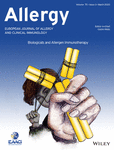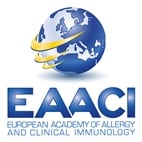Journal list menu
Export Citations
Download PDFs
ISSUE INFORMATION
Issue Information - Cover and Editorial Board
- Page: 487
- First Published: 10 March 2020
IN THIS ISSUE
EDITORIAL
Allergen immunotherapy for asthma: Looking “Back to the Future”
- Pages: 495-496
- First Published: 20 July 2019
EAACI POSITION PAPER
EAACI position paper on diet diversity in pregnancy, infancy and childhood: Novel concepts and implications for studies in allergy and asthma
- Pages: 497-523
- First Published: 14 September 2019
REVIEW ARTICLES
Regulation of immunity and allergy by helminth parasites
- Pages: 524-534
- First Published: 12 June 2019
Risk factors and indicators of severe systemic insect sting reactions
- Pages: 535-545
- First Published: 13 June 2019
New biological treatments for asthma and skin allergies
- Pages: 546-560
- First Published: 23 August 2019
Progress in understanding hypersensitivity reactions to nonsteroidal anti-inflammatory drugs
- Pages: 561-575
- First Published: 30 August 2019
ORIGINAL ARTICLES
Experimental Allergy and Immunology
Pollen exposure weakens innate defense against respiratory viruses
- Pages: 576-587
- First Published: 11 September 2019
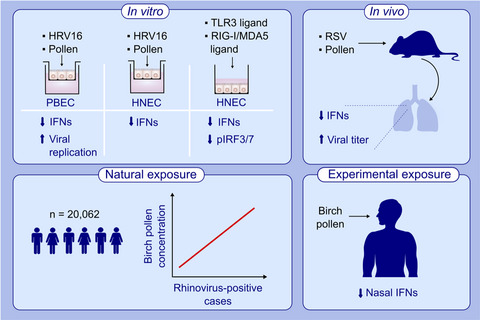
Pollen significantly diminished the epithelial response to rhinovirus infectionand viral mimics, and decreased nuclear translocation of IRFs. In a murine RSV infection model, pollen increased pulmonary viral load in the absence of allergic sensitization. Evidence from different, independent human cohorts suggests that springtime pollen exposure compromises the respiratory antiviral response, not only in allergic, but also in non-allergic individuals.
Abbreviations: HNEC, human nasal epithelial cells; HRV16, human rhinovirus 16; IRF, interferon regulatory factor; MDA5, melanoma differentiation-associated protein 5; PBEC, primary bronchial epithelial cell; RIG-I, retinoic acid inducible gene-I; RSV, respiratory syncytial virus; TLR3, toll-like receptor 3
The EAACI-AAAAI-WAO Junior Members’ joint survey: A worldwide snapshot of Allergy and Clinical Immunology specialty
- Pages: 588-595
- First Published: 16 September 2019
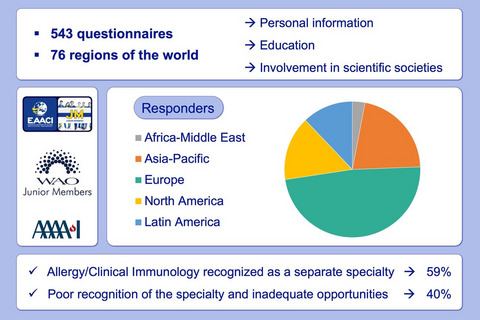
The first worldwide perspective about Allergy/Immunology (A/I) Specialty, as depicted by the young members of the three main scientific societies in the field, has been realized. A great variability among different countries characterizes the specialty in terms of recognition, background formation, job/research/grants opportunities, and involvement of JMs into the societies’ activities. Overall, passion and enthusiasm for the specialty remain the strongest motivation for being active in the A/I field, although many critical aspects cannot be avoided.
Asthma and Lower Airway Disease
The moderating role of allergy immunotherapy in asthma progression: Results of a population-based cohort study
- Pages: 596-602
- First Published: 13 August 2019
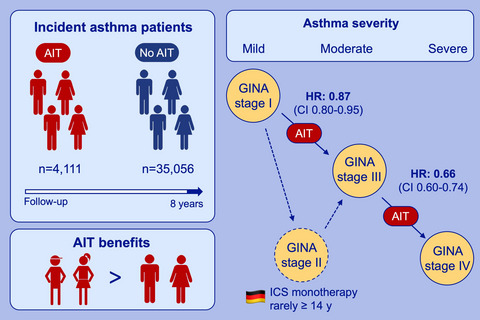
In a large cohort study of 39,167 asthma patients, those with AIT had a decreased likelihood for disease progression, measured in symptomatic medication according to GINA. Younger patients benefited most from AIT, which is reflected in prevention or delay of asthma progression. Inhaled corticosteroids (ICS) monotherapy (GINA stage 2) is rarely prescribed in Germany for asthma patients over 14 years.
Acid sphingomyelinase regulates TH2 cytokine release and bronchial asthma
- Pages: 603-615
- First Published: 08 September 2019
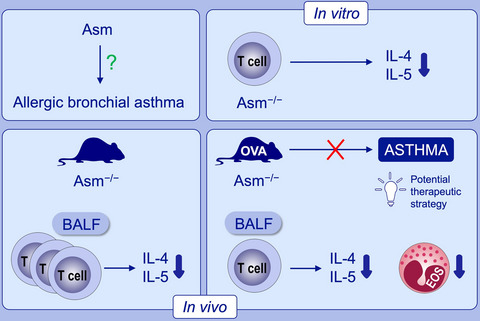
This study investigated the role of acid sphingomyelinase (Asm) in allergic bronchial asthma. Asm deficiency resulted in reduced TH2 cytokine release both in vitro and in vivo. In the ovalbumin model, ASM−/− mice were protected from bronchial asthma, showed decreased production of TH2 cytokines and lower number of eosinophils.
Abbreviations: Asm, acid sphingomyelinase; BALF, bronchoalveolar lavage fluid; OVA, ovalbumin
Food Allergy and Gastrointestinal Disease
Performance of basophil activation test and specific IgG4 as diagnostic tools in nonspecific lipid transfer protein allergy: Antwerp-Barcelona comparison
- Pages: 616-624
- First Published: 11 September 2019
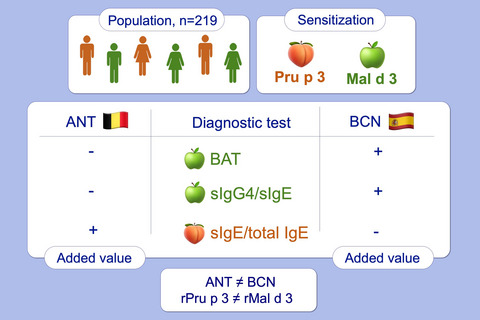
This study explores the performance of BAT, sIgE/total IgE, sIgG4 and sIgG4/sIgE ratio in Pru p 3- and Mal d 3-sensitized populations from Antwerp (ANT) and Barcelona (BCN). In BCN, only ratios of sIgG4/sIgE rMal d 3 and BAT rMal d 3 can identify clinically relevant Mal d 3 sensitization, whereas in ANT, only the sIgE/total IgE rPru p 3 ratio shows added value. NsLTP sensitization and diagnostic performance cannot be extrapolated from one population to another. BAT, basophil activation test; nsLTP, nonspecific lipid transfer protein.
Endotoxin, food allergen sensitization, and food allergy: A complementary epidemiologic and experimental study
- Pages: 625-635
- First Published: 19 September 2019
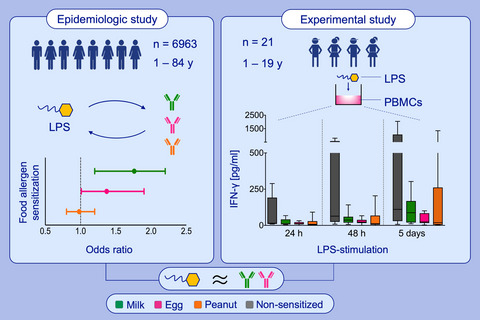
Epidemiologic study of NHANES participants (n = 6963) revealed associations between household endotoxin level and sensitization to milk or egg, but not peanut. Complementary experimental study showed attenuated interferon- γ responses from endotoxin stimulation of PBMCs from children with allergy to milk or egg, but not peanut. These complementary findings suggest that endotoxin’s effects on food sensitization/allergy may differ by food allergy type.
Abbreviations: NHANES, National Health and Nutrition Examination Survey
Drug Allergy, Insect Sting Allergy, and Anaphylaxis
Modification of the cyclopropyl moiety of abacavir provides insight into the structure activity relationship between HLA-B*57:01 binding and T-cell activation
- Pages: 636-647
- First Published: 24 September 2019
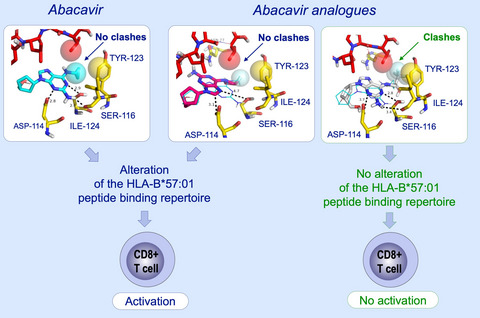
Structural modelling aids prediction of the impact of abacavir modifications on the activation of CD8+ T-cells. Abacavir analogues that stimulate CD8+ T-cells display a perturbation of natural peptides displayed by HLA-B*57:01. Enantiomeric forms of abacavir predicted to adopt different HLA-B*57:01 binding conformations display divergent CD8+ response profiles.
Alum impairs tolerogenic properties induced by allergoid-mannan conjugates inhibiting mTOR and metabolic reprogramming in human DCs
- Pages: 648-659
- First Published: 08 September 2019
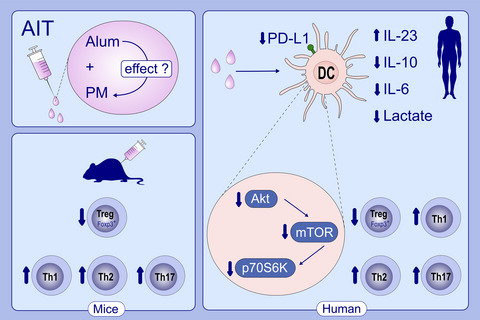
This study investigated the potential influence of alum in the tolerogenic properties imprinted by PM. Alum decreased expression of PD-L1 and production of IL-10, IL-6 and lactate, increased IL-23 release and inhibited mTOR activation in PM-activated DCs. Alum suppressed PM-induced functional FOXP3+ Treg cells and promoted Th1/Th2/Th17 responses.
Epidemiology and Genetics
Allergic rhinitis and allergic sensitisation are still increasing among Danish adults
- Pages: 660-668
- First Published: 11 September 2019
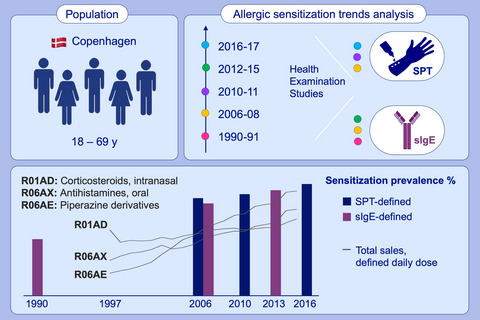
We assessed whether the prevalence of allergic respiratory disease has continued to increase in the current millennium among Danish adults. Both specific IgE (sIgE) and skin-prick test (SPT) sensitization showed an increase from 2006 to 2013-2016. These trends were supported by a nationwide increase in annual sales (including over-the-counter drugs) of intranasal corticosteroids and oral antihistamines from 1997-2015.
LETTERS TO THE EDITOR
Mepolizumab failed to affect bullous pemphigoid: A randomized, placebo-controlled, double-blind phase 2 pilot study
- Pages: 669-672
- First Published: 22 June 2019
International compliance with WHO infant feeding guidelines – Is the confusion cause for concern?
- Pages: 673-674
- First Published: 13 July 2019
Concomitant bilastine and montelukast as additive therapy for seasonal allergic rhinoconjunctivits and mild-to-moderate asthma. The SKY study
- Pages: 675-677
- First Published: 02 August 2019
A safe and efficient 7-week immunotherapy protocol with aluminum hydroxide adsorbed vespid venom
- Pages: 678-680
- First Published: 08 August 2019
T-cell receptor repertoire data provides new evidence for hygiene hypothesis of allergic diseases
- Pages: 681-683
- First Published: 08 August 2019
CTLA-4-competent conventional T cells back up regulatory T cells to restrain memory T-helper type 2 cell responses
- Pages: 684-687
- First Published: 10 September 2019
Effects of inhaled corticosteroids on DNA methylation in peripheral blood cells in children with asthma
- Pages: 688-691
- First Published: 09 September 2019
Coeliac disease and HLA-conferred susceptibility to autoimmunity are associated with IgE sensitization in young children
- Pages: 692-694
- First Published: 17 September 2019
Type I interferon suppresses memory Th2 cell cytokine secretion from allergic subjects
- Pages: 695-698
- First Published: 21 September 2019
Circulating neutrophil and eosinophil extracellular traps are markers of severe asthma
- Pages: 699-702
- First Published: 24 September 2019
MiR-31-5p: A shared regulator of chronic mucus hypersecretion in asthma and chronic obstructive pulmonary disease
- Pages: 703-706
- First Published: 23 September 2019
Novel aspects of mast cell and basophil function: Highlights from the 9th meeting of the European Mast Cell and Basophil Research Network (EMBRN)—A Marcus Wallenberg Symposium
- Pages: 707-708
- First Published: 26 September 2019
Mass spectrometry confirmation that clinically important peanut protein allergens are present in household dust
- Pages: 709-712
- First Published: 04 October 2019
Neutrophils are underrecognized contributors to inflammatory burden and quality of life in chronic rhinosinusitis
- Pages: 713-716
- First Published: 04 October 2019
Muscarinic receptor M3 contributes to vascular and neural growth factor up-regulation in severe asthma
- Pages: 717-720
- First Published: 04 October 2019
Simultaneous up-dosing of bee and vespid venom immunotherapy is safe
- Pages: 721-723
- First Published: 08 October 2019
NEWS & VIEWS
LEGENDS OF ALLERGY AND IMMUNOLOGY
Legends of allergy and immunology: Donald Y. M. Leung
- Pages: 724-726
- First Published: 29 August 2019
Algorithms in Allergy and Clinical Immunology
Medical algorithm: Diagnosis and treatment of eosinophilic esophagitis in adults
- Pages: 727-730
- First Published: 12 November 2019




